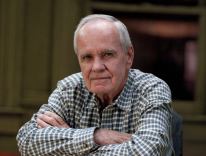Owen Chadwick’s history of Christianity is an old-fashioned, straightforward narrative, but it is never a lockstep chronological series of Great Events and Great Persons. To be sure, there are many great events and great persons, but what saves this book from being a retelling of “one damned thing after another” is Chadwick’s graceful and vigorous prose and his willingness to interrupt his narrative for excursuses on small but lively points about the Christian tradition. In a section on saints, for example, he explains how the nimbus (the halo or corona) evolves in Christian art; he comments on the rise of the confessional box; and he finds time to muse on the use of bells in the Christian church.
A History of Christianity
by Owen Chadwick
St. Martin’s, $35, 304 pp.
Chadwick’s story is enhanced by illustrations drawn from the long history of Christian art. Many of these illustrations are in full color and placed so as to shed light on the text. When I got this modestly priced volume, I spent a rainy Saturday morning just turning the pages and looking at the art, pausing now and again to read one of his brief essays on this or that topic. In short, the book is an excellent browse, but it could also serve as a more formal introduction to church history. Perhaps the publisher might think of a soft-cover edition that could find some classroom usage. In the meantime, it is a book well worth the price.
Prepared in Rome by the Theological-Historical Commission for the Great Jubilee 2000, Adrian Walker’s translation of Jesus Christ is the first of four catechetical texts that will be published under the aegis of the Vatican commission. The fact that the publication of this volume comes with little fanfare in this country indicates that, however feverish the preparations may be in Rome, excitement over the Jubilee seems not to be contagious. That is a shame since this book, despite some pedagogical shortcomings and a committee-derived clunkiness, does provide an example of how the lumpily unwieldy Catechism of the Catholic Church can be translated into something approaching manageable readability. But whether this christological catechesis will attract a wide readership remains to be seen.
Jesus Christ:
Word of the Father/Savior of the World
compiled by the Theological Historical Commission for the Great Jubilee 2000
translated by Adrian Walker
Crossroad/Herder, $12.95, 156 pp.
As the title indicates, the commission focuses on the mystery of the Incarnation. Divided into ten chapters, it begins with an extended meditation on Paul’s trope (Gal. 4:4-6) that Christ came in the “fullness of time” born “of a woman, born under the Law,” to provide us with the spirit of adoption as children of God. This catechesis sees Jesus Christ as the center of history and the center of time. Despite this rather high christological affirmation, the text not only pays sincere attention to the popular faith of the church, but insists that we note how other cultures (non-Western ones) have attempted to “name” Christ by drawing on both revered titles (Christ as Guru) as well as hallowed virtues (Jesus as teacher of ahimsa-nonviolence).
The fifth and sixth chapters of the book are most impressive in their description of Jesus as preacher, healer, forgiver of sins, friend of the emarginated, companion of women, and prophet of peace and reconciliation. Chapter 6 (with perhaps a little too much apologetical fretting) sets out the faith of Christians in the Resurrection and the implications of that great culminating reality of Jesus’ earthly life. The final chapter is on Mary but, following the lead of Lumen gentium at Vatican II, sets its course in the light of the preceding reflections on the Incarnation.
This is not a perfect book. I have noted its tendency toward apologetics (a tendency in reaction against the widespread publicity about the Jesus Seminar and other such extravaganzas?); its overemphasis on papal documents; its not infrequent lapses into theological jargon. Against that, however, there are wonderful pages on the gospel message of Jesus coupled with the text’s urgent sense of what salvation really means and how this message is at the core of the teaching of the church. In the final analysis, this book does give us hope that others will attempt such catecheses in order to turn the “stuff” of the Catechism of the Catholic Church into a more readable format. If I had been working on this manuscript, I would have made it more “user friendly,” adding some short prayers, providing a few well-chosen illustrations, avoiding the intrusive patches of Latinate Vaticanese, and, most of all, supplying an index.
The Reformation of the Bible is not a book I would have spontaneously purchased, but having received it I found it an admirable volume to study. The book is, in effect, a catalog of a museum show of Bibles and related materials produced originally in the fifteenth and sixteenth centuries. The exhibit opened at Southern Methodist University and subsequently traveled to Yale, Harvard, and Columbia.
The Reformation of the Bible/The Bible of the Reformation
by Jaroslav Pelikan
Yale University Press, $45, 197 pp.
Pelikan’s introductory essay is exactly what one would expect from this prolific scholar: deeply learned, unfailingly interesting, and written with clarity and ease. Pelikan emphasizes that the Renaissance humanists, especially those in the North, passionately believed that philology could be used as an instrument of Christian reform. That conviction also undergirded their prodigious labors at producing critical texts of the Bible, fostering the study of Hebrew and Greek, their investigations into patristics, etc. That humanist conviction also coincided with the newer printing technologies developed after the pioneering work of Gutenberg, and was a decisive factor in the spread of Reformation ideas.
Pelikan develops his introductory essay along a series of fronts: critical editions of the biblical texts; the ways in which biblical exegesis developed as a result of critical work; the means by which the Bible became available to people at large; and how this new interest in the Bible fed the various arts of the sixteenth century, including the ancillary disciplines of literature, etc.
Along with Pelikan’s long essay there are over eighty illustrations of title pages, illustrated pages, woodblocks, and etchings from fifteenth-, sixteenth-, and seventeenth-century books. Each illustration has a long explanatory note and a short bibliography. There are wonderful treats to be enjoyed here (even if the use of a magnifying glass is needed to see some details), ranging from polyglot typefaces on a single page to wonderful examples of Dürer’s woodcuts from his 1511 “Large Passion.”
This volume might seem a bit specialized but Pelikan’s essay is accessible to the general reader and the illustrations from the catalogue section are wonderful to browse through. Bibliophiles will delight in both the rarity of the volumes and the splendid typefaces produced in this period of great art. Any lover of the Bible or books in general would be glad to receive this handsome book as a gift.
The Bible, of course, is not meant only to be read. The Bible is both performed in the sacramental, liturgical, charitable, and prophetic work of the church as well as being proclaimed and preached. Hilkert’s book is about the exercise of preaching, but not from the perspective of technique or rhetoric. This is not a book on homiletics. One could say that her theological reflection revolves around this issue: how does the preached word take flesh? Can one theologically locate the point where the inspired Word of God touches the concrete flesh-and-blood community of believers? Does the preached word actually become a sacrament in the traditional sense of that term?
Naming Grace:
Preaching and the Sacramental Imagination
by Mary Catherine Hilkert
Continuum, $29.95, 252 pp.
Drawing on a wide range of scholarship, Hilkert urges a kind of triangulation that involves coordinating the story of salvation with one’s own story and the story of the world in which we live. The task of the preacher is to account for multiple fidelities: to the Word, to the hearer, and to the world. Precisely because preaching is sacramental, the preacher’s task is, in Hilkert’s estimation, more akin to the poet’s than to the teacher’s, in the sense that the preacher must bring forth words (Rahner would call them Urwortes-fundamental words) that re-call the mystery of God and the mystery of human experience. That task, in turn, raises powerful issues: should preaching teach or should it proclaim? How does one approach biblical texts that, say, demean women? (Hilkert follows Sandra Schneider’s lead in arguing that one can preach against a text; she does not accept Elizabeth Fiorenza’s suggestion that the canon be trimmed.) Who has the right to preach? Along with “problems,” however, comes Hilkert’s affirmation that the sacramental imagination is still vigorous and that preaching can thrust forward “images of hope.”
I joked with Hilkert (she is a colleague) that her endnotes are almost as interesting as her text. She has read everything on this topic and, as a consequence, her notes could provide a handy syllabus on particular topics along the entire theological spectrum. This book is a theological delight, especially because the author effortlessly links preaching to sacramental theology and ecclesiology. My own prayer is that it will be read not by theologians alone. it should be studied especially carefully by everyone who has the ministry of preaching, so that they can relearn what, at times, they seem to forget: that what they do is fundamental, urgent, and always needed.
Abingdon’s has recently reissued Louth’s very fine 1991 volume on the theme of the desert in Christian spirituality. The desert is more than a theme in the Bible; it serves almost as a purificatory step for both the Children of Israel and Jesus. thus, by extension, it is a source for our own spiritual journey. The Bible insists that the desert is both a place of evil powers (Louth has an interesting chapter on the demonic displays at Loudun in seventeenth-century France) and violence, as well as locus for finding God.
The Wilderness of God
by Andrew Louth
Abingdon, $14.95, 171 pp.
Louth’s exemplary little volume takes up, in separate chapters, figures from the history of Christian spirituality who actually lived the desert experience geographically (Charles DeFoucauld, Carlo Carretto, the Desert fathers and mothers, the Russian forest dwellers) or who “constructed” a desert metaphorically as part of the spiritual journey (John of the Cross, Julian of Norwich, T.S. Eliot). In each of these chapters Louth weaves together both narrative and a close reading of texts. In that way, the reader learns some history but, more important, comes to understand the fecundity of the desert symbol.
These chapters, well-researched and crisply narrated, provide us with permutations of a biblical theme as it is received and “performed” in the history of the spiritual tradition. Louth is a well-known scholar of patristics who wears his learning lightly and his piety openly. In that sense, he is always instructive to read.
Were I to have had the chance to comment on this book before its publication, I might have suggested that he do a separate chapter (or chapters) on the man-made deserts of this century. One of the great resources of contemporary spirituality is to mine the memoirs and reflections of those who have lived through the deserts of postindustrial urban life or the darkly demonic deserts of this century’s gulags, death lagers, and refugee camps. In that sense, the desert dwellers of today are figures like Mandela, Wiesel, etc. Perhaps someone, using Louth’s excellent book as a kind of traditional model, will do another book with the title The Wilderness without God. Such a project would be one small way of fulfilling Pope John Paul’s intention to compile, for the millennial celebrations, a martyrology of twentieth-century Christians.
I have a goodly number of friends who, from their roots in Protestant fundamentalism or Roman Catholicism, have joined one or other of the branches of Eastern Christianity. Our local Melkite church, for example, has a core of native Melkites, but the preponderant number of the congregation are refugees from Roman Catholic guitar masses. Mathewes-Green’s book tells of her conversion and that of her spouse from the Episcopal church to the Orthodox church; her husband, in fact, is the priest in their small community which, like that of our Melkite parish, is made up mainly of converts from other Christian denominations. The author alludes in passing to her own journey from a Roman Catholic youth through a Hindu phase to the charismatics to the Anglicans to Orthodoxy.
Facing East:
A Pilgrim’s Journey into the Mysteries of Orthodoxy
by Frederica Mathewes-Green
HarperSan Francisco, $20, 245 pp.
Mathewes-Green frames this book by following the liturgical year and its rituals while telling the story of the fledgling Orthodox congregation where her husband serves as pastor. Since most non-Orthodox find that tradition somewhat exotic, her book is an insider’s view of Orthodox life and practice. A glossary at the end helps those who need assistance with the vocabulary. I suspect that this book will be of special interest to the many new converts to Orthodoxy who wish to make sense of their new faith and its, if you will excuse the pun, rather Byzantine usages.
Like most converts, the author is breathlessly uncritical about her new faith and, irritatingly, smugly critical of others. She sniffs at the brevity of Presbyterian Easter services; tsk-tsks the lack of fasting in other denominations; faults the Catholics for seeking salvation through works (on what basis I’m not sure) while, at the same time, urging mildly dubious claims about the antiquity of certain Orthodox practices. This is hardly to be taken as a severe criticism since, mutatis mutandis, it is a common fault of the genre.
The publisher’s blurb describes the move toward Orthodoxy as one of the “hottest trends in American Christianity.” The phrase “hottest trends” is a depressing one in its own right, but it does unwittingly state a paradox: many people find Orthodoxy attractive precisely because it stands squarely against most “hot” trends in American life. The Eastern Christian tradition is unfathomably rich, and some of those riches become clear on the pages of this book. This work, then, may be a harbinger of others to come. Let’s hope it finds a wide audience who appreciate, in the words of the gospel, bringing forth old things and new.
Please email comments to [email protected] and join the conversation on our Facebook page.
Share
Previous Story
Woza Afrika
Next Story
American Catholic


